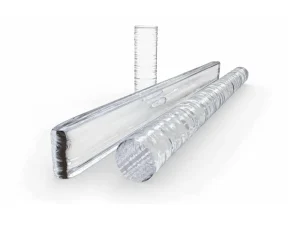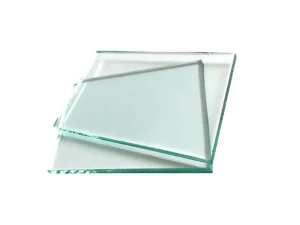Glass material is of utmost value. It is used to make a variety of products, including glass bottles, containers, and jars. There are two significant types of glass used in different products. Those include borosilicate and regular glass types. Both of these glass types offer unique properties. As a result, a debate arises over borosilicate glass vs regular glass.
Both of these types offer unique properties and are suitable for different conditions. Borosilicate glass is ideal when the strength of the glass product is a priority. However, regular glass is an option for people on a tight budget. In this article, I will discuss the differences between borosilicate and regular glass. So, let’s get started!
Overview of High Borosilicate Glass & Regular Glass

Let us first guide you on the basics of these glass types before discussing their differences.
High borosilicate and regular borosilicate differ in their chemical composition. Borosilicate glass consists of boron oxide (about 10%) along with soda and silica. The presence of boron oxide makes this glass strong and heat-resistant. However, regular glass is less durable and known for its affordability.
In simple terms, borosilicate glass is more premium and is used to make durable glass materials. Regular glass is cheaper, less durable, and readily available. Both of these glass types differ in composition. Borosilicate glass consists of three components, namely silica, soda, and boron oxide.
However, the regular glass consists of silica, soda ash, and lime. Remember, silica means sand, and it’s the primary ingredient in these glass types. It accounts for about 70% of the total composition of regular glass. Borosilicate glass contains boron oxide, a major distinguishing factor. This ingredient makes borosilicate glass heat-resistant.
As a result, this glass type can easily withstand extreme temperatures without cracking. As a result, you’ll see borosilicate glass used in many laboratory products. However, regular glass is not heat-resistant and cracks when exposed to high temperatures. So, regular glass offers compromised durability, which is its drawback.
Differences Between Borosilicate Glass and Regular Glass
In simple words, borosilicate glass is a superior option because of the presence of boron oxide in its composition. Apart from composition, there are many other differences between these glass types. In the section below, I will discuss each of those differences to help you choose the right glass type.
1- Manufacturing Process

Manufacturing of borosilicate and regular glass is almost the same. Let’s first discuss the production of borosilicate glass. First, the raw materials (silica, soda, boron oxide) are mixed. Once mixed, the mixture is heated to about 1,800 degrees Celsius. This extreme heat melts the mixture, and manufacturers then cool and shape it.
In this way, we get the final borosilicate glass. For regular glass, the raw materials differ. First, the silica, lime, soda, etc., are mixed without adding boron oxide. After this, the mixture undergoes heat treatment at a lower temperature of around 1,300 degrees Celsius. After that, cooling and shaping are performed to produce regular glass.
Quick Highlight: Borosilicate production requires temperatures up to 1,800 degrees Celsius. Achieving this high temperature is very difficult and demands high energy. As a result, the production of borosilicate glass is more complex and challenging. On the other hand, regular glass types are easier and quicker to produce.
2- Chemical Composition
As I said earlier, the primary difference between borosilicate and regular glass is in its composition. Both consist of multiple ingredients (mixtures). A few of those ingredients are similar in both glass types. Those include silica, soda, and lime. However, the proportions of these ingredients differ between the two glass types.
But the presence of boron oxide in borosilicate glass creates differences between these two glass types. Here is the table highlighting the chemical composition of these two glass types:
| Component | Borosilicate Glass | Regular Glass |
| Silica (SiO₂) | 70–80% | 70–74% |
| Boron Oxide (B₂O₃) | 7–13% | 0% |
| Soda (Na₂O) | 4–8% | 12–16% |
| Alumina (Al₂O₃) | 2–7% | 0–2% |
| Lime / Calcium Oxide (CaO) | 0–5% | 8–12% |
| Other Oxides | Around 2% | 2–4% |
3- Thermal Resistance
Borosilicate glass is a superior option compared to regular glass for thermal impact. Thermal impact or shock occurs when a material fractures due to heating or cooling. Remember, glass expands when exposed to high temperatures. Similarly, it contracts when the temperature is reduced. This expansion of glass can cause it to break if it has no thermal resistance.
The borosilicate glass contains about 10% boron oxide. This oxide reduces the rate of expansion and makes the glass heat-resistant. As a result, borosilicate glass remains stable at high temperatures. Sudden increases or decreases do not cause cracks in this glass type. However, the regular glass can crack when exposed to high temperatures.
4- Weight and Clarity (Aesthetics)
The borosilicate glass feels a bit lighter and clearer than its counterpart. Why? The reason is that this glass type uses less material than regular glass. It contains boron oxide, which increases its strength and heat resistance. So manufacturers use less borosilicate material and make the glass thinner. Remember, less material means lighter glass.
Additionally, the borosilicate glass looks more transparent and clear due to its thin walls. On the other hand, regular glass is somewhat less durable due to the lack of boron oxide. As a result, manufacturers use more material and keep the glass thicker. Thicker material means a higher weight, and less clear glass will be. You should choose borosilicate glass if you prefer lightweight, high clarity.
5- Chemical Resistance & Safety

When I say “Chemicals,” I mean acids, alkalis, and other impurities. Borosilicate glass offers excellent chemical resistance. Better resistance to chemicals means excellent safety. How is borosilicate chemically resistant? That’s because of the high boron oxide content in this glass type.
Remember, boron oxide is the least reactive, so borosilicate doesn’t react with chemicals. As a result, the glass remains safe and retains its color over time. On the other hand, regular glass doesn’t contain boron oxide, making it an inferior option. No boron means regular glass can react with some chemicals. As a result, this material becomes less safe. In fact, if you leave an acidic drink in a glass bottle, it will start to lose its color quickly.
6- Durability and Strength
I consider borosilicate glass to be much more durable than regular glass. The reason is that this borosilicate glass has excellent thermal resistance. It means it remains stable when the temperature changes quickly. This makes borosilicate strong and resistant to breaking. Additionally, this type of glass comes with boron oxide.
This oxide imparts excellent strength and heat resistance. As a result, this glass type is exceptionally rugged and durable. On the other hand, the regular glass has low thermal resistance. Moreover, it lacks boron oxide, which is another major drawback. Due to this, the regular glass is less durable and can break easily.
7- Cost & Common Application (Use Cases)
Borosilicate glass is much more expensive than regular glass. Why? That’s because of the complex manufacturing process and composition of this borosilicate glass. Remember, this glass consists of boron oxide, silica, and soda. This additional boron oxide is expensive, which raises the price of boron silicate.
However, this glass type offers excellent durability and thermal stability. I consider this glass to be used for high-durability products. On the other hand, regular glass is cheaper. This is due to a more straightforward production process and the use of cheaper raw materials in these glasses. However, this glass type is used in everyday products.
Here is a table showing the application comparison of borosilicate and regular glass types:
| Borosilicate Glass | Regular Glass |
| Laboratory glassware | Windows and doors |
| Oven-safe cookware and bakeware | Drinking glasses, jars, bottles |
| Premium water bottles and tea kettles | Mirrors and picture frames |
| Medical and pharmaceutical equipment | Everyday tableware |
| LED and light fixtures | Decorative glass items |
| Solar panel covers | Standard containers and jars |
Frequently Asked Questions
What is the difference between borosilicate glass and regular glass?
The borosilicate glass contains boron oxide (about 10%). On the other hand, regular glass does not contain boron oxide and consists only of lime, silica, and soda. As a result, borosilicate glass is stronger and more thermally resistant than regular glass.
What are the disadvantages of borosilicate glass?
There are two significant drawbacks of borosilicates. First of all, its manufacturing is more complex and requires temperatures of around 1,800 degrees. Additionally, borosilicate glass is costly.
Conclusion: Which Glass Type Should You Choose?
In most cases, borosilicate glass is a superior option. What I like about this glass type is its excellent thermal resistance. Suppose you have a glass bottle made of this material. You can easily use it at high or low temperatures without worrying. These glass bottles won’t break or crack.
However, the cost of borosilicate materials can be a hurdle for many. If you’re someone with a tight budget, I recommend choosing a regular glass type. Although this glass is not durable, it can be a good starting point. Remember, some products don’t require extreme durability. You can use the regular glass to make such glass products. In this article, I’ve discussed all the differences between borosilicate and regular glass.
